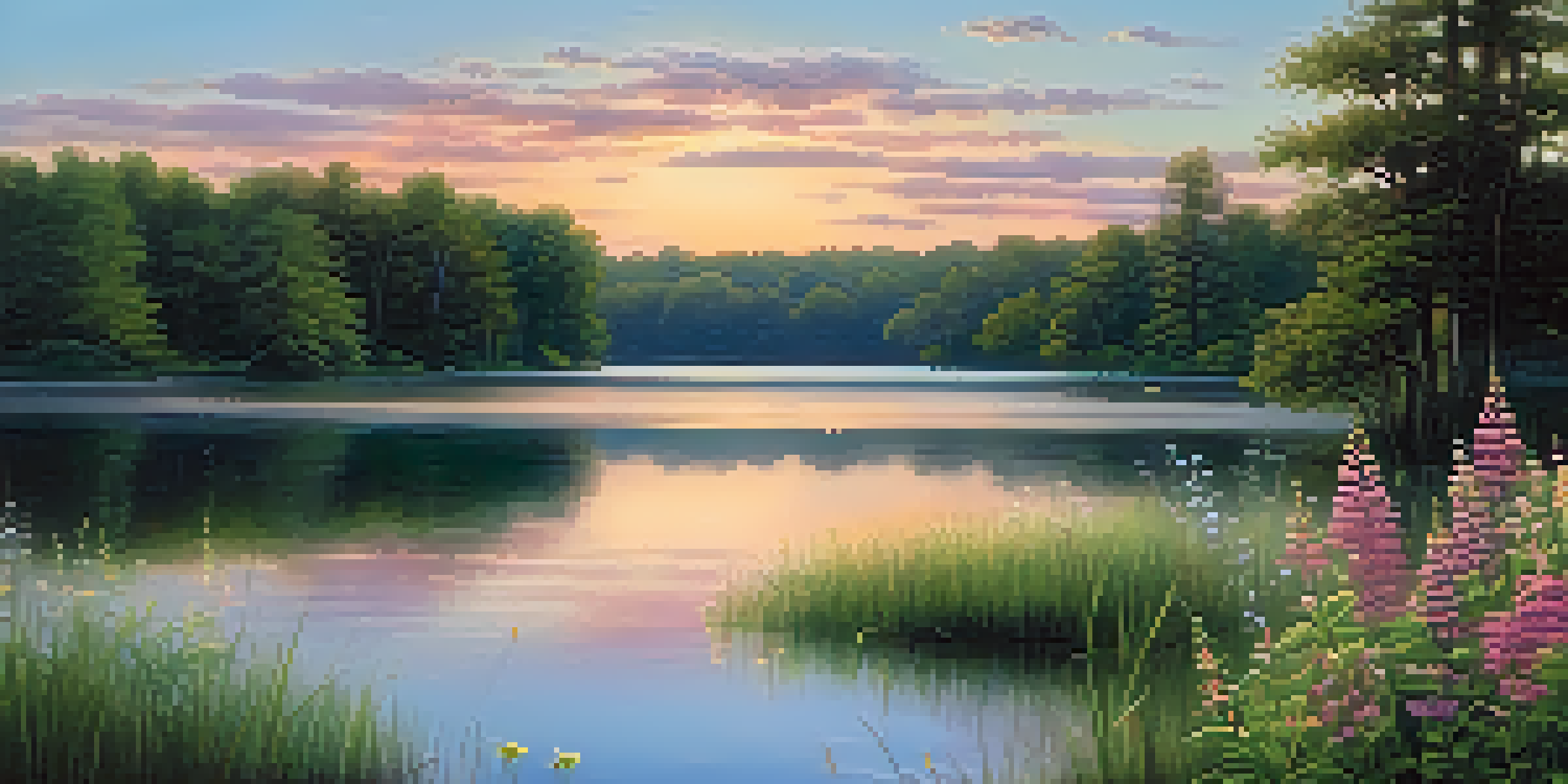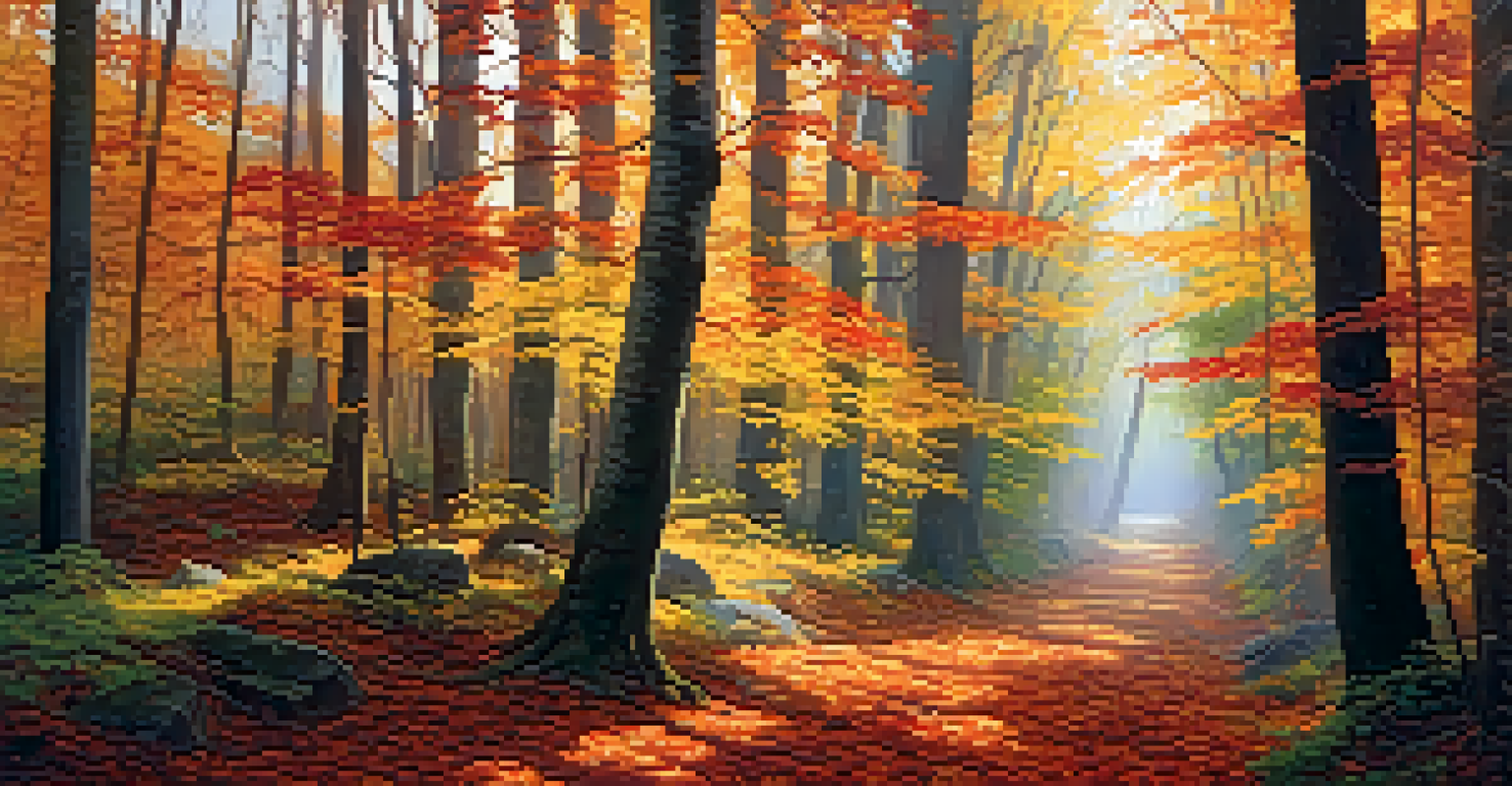Landscape Painting: Nature as a Reflection of Human Emotion

Understanding Landscape Painting's Emotional Depth
Landscape painting is more than just a depiction of nature; it is a deep reflection of human emotions. Artists often use the natural world to convey feelings that words cannot express. For instance, a serene lake may evoke tranquility, while a stormy sky can illustrate turmoil. This emotional connection helps viewers relate to the artwork on a personal level.
The painter tries to master light, color, and form to express his feelings, not merely to imitate nature.
The beauty of landscape painting lies in its ability to capture fleeting moments. Each brushstroke can signify a feeling or memory, inviting the observer to pause and reflect. Whether it's the warmth of a sunset or the chill of a winter's day, nature serves as a canvas for our innermost thoughts. Through landscapes, artists create a dialogue between the viewer's emotions and the environment.
Furthermore, the choice of colors and techniques in landscape paintings plays a crucial role in conveying emotions. Lush greens and bright yellows can evoke joy, while dark blues and grays might suggest sadness or contemplation. This intentional use of color invites the viewer to experience the artist's emotional landscape, bridging the gap between nature and sentiment.
Nature as a Source of Inspiration for Artists
Throughout history, nature has been a timeless source of inspiration for artists. From the rolling hills of the English countryside to the rugged cliffs of the American West, each landscape offers a unique perspective. Artists often find solace and creativity in natural settings, allowing them to tap into their emotions and experiences. This connection enhances their artistic expression.

For example, the Impressionists, like Claude Monet, captured the changing qualities of light and atmosphere in their works. Monet's series of water lilies not only depict a serene garden but also reflect his emotional state as he faced personal challenges. Through these landscapes, viewers gain insight into the artist's mind, creating a shared emotional experience.
Emotional Depth in Landscapes
Landscape painting serves as a profound reflection of human emotions, allowing artists to convey feelings that resonate with viewers.
Moreover, the act of painting in nature, known as plein air painting, encourages a deeper connection between the artist and their surroundings. This immersion not only influences their artistic choices but also allows emotions to flow freely onto the canvas. The result is a landscape that resonates with viewers, inviting them to explore their own feelings.
Symbolism in Landscape Painting: More Than Meets the Eye
Symbolism is a powerful tool in landscape painting, adding layers of meaning to the artwork. Artists often incorporate natural elements that represent specific emotions or concepts. For instance, a lone tree on a hill might symbolize solitude, while a blooming flower can signify hope and renewal. These symbols invite viewers to delve deeper into the narrative behind the landscape.
Art is the most beautiful of all lies; it is a reflection of our deepest emotions.
Take, for example, the use of mountains in art. They often represent strength and permanence, contrasting with the ephemeral nature of clouds or water. This juxtaposition can evoke feelings of stability amidst chaos. By interpreting these symbols, viewers can connect with their own life experiences, creating a personal relationship with the painting.
Additionally, landscapes can reflect cultural and societal emotions. For example, during times of conflict, artists might portray barren landscapes to convey despair or loss. This ability to use nature as a metaphor for human experience enriches the emotional depth of the painting, making it resonate even more powerfully with the audience.
The Role of Light and Color in Emotional Expression
Light and color are essential components of landscape painting that profoundly impact emotional expression. The way light interacts with landscapes can create different moods. Soft, warm light during sunrise can evoke feelings of hope and renewal, while harsh, cold light can suggest isolation or loneliness. This dynamic interplay invites viewers to experience the landscape on an emotional level.
Color theory also plays a vital role in conveying feelings through landscape painting. Artists choose colors deliberately to elicit specific emotional responses. For instance, warm colors like reds and oranges can create a sense of warmth and excitement, whereas cooler colors like blues and greens often evoke calmness and serenity. This thoughtful color palette helps to communicate the artist's emotional narrative.
Nature Inspires Artistic Expression
Artists draw inspiration from natural settings, using their experiences to create landscapes that evoke personal and shared emotions.
Moreover, the changing seasons offer a rich palette of colors that reflect different emotions. Spring is often associated with rebirth and joy, while autumn can evoke nostalgia and change. By capturing these seasonal shifts, artists can connect with viewers' emotions, tapping into universal feelings tied to the cycles of nature.
Personal Experiences: Artists Infuse Emotion into Landscapes
Many artists draw upon their personal experiences when creating landscape paintings, infusing their work with genuine emotion. These experiences shape their perspective, influencing how they interpret and depict natural scenes. For example, an artist who finds solace in nature may paint a tranquil landscape that reflects their inner peace, inviting viewers to share that sentiment.
Anecdotes from artists often reveal how significant life events inspire their work. A painter might create a vibrant sunset after a joyful occasion, while a winter scene might emerge from a period of introspection. This authenticity allows viewers to connect with the artwork on a deeper level, as they sense the emotions behind the brushstrokes.
Ultimately, the personal journey of artists transforms landscapes into powerful emotional narratives. By sharing their experiences through art, they create a bridge between their emotions and those of the audience. This shared connection fosters empathy and understanding, making landscape paintings resonate far beyond their visual appeal.
The Impact of Technology on Landscape Painting
In recent years, technology has significantly impacted landscape painting, both in technique and accessibility. Digital tools and software have expanded the possibilities for artists, allowing them to experiment with colors and compositions more freely. This evolution opens new avenues for emotional expression, as artists can instantly adjust their work to better reflect their feelings.
Furthermore, online platforms have made landscape art accessible to a broader audience. Artists can share their work with people around the world, fostering connections and discussions about the emotions conveyed in their pieces. This digital interaction creates a sense of community, encouraging viewers to share their interpretations and emotional responses to the artwork.
Symbolism Enhances Emotional Impact
Incorporating symbols and thoughtful use of light and color in landscapes adds layers of meaning, enriching the viewer's emotional experience.
However, traditional methods still hold a special place in landscape painting. Many artists continue to prefer working with physical media, as the tactile experience of painting can evoke a unique emotional response. This blend of traditional and modern techniques allows for diverse expressions of emotion, ensuring that landscape painting remains a dynamic and evolving art form.
Conclusion: Landscape Painting's Enduring Emotional Legacy
Landscape painting, with its deep emotional connections, continues to captivate audiences worldwide. By using nature as a mirror for human emotions, artists create works that resonate with personal experiences and feelings. Each landscape serves as a reminder of our connection to the world around us, inviting us to reflect on our own emotions.
As we explore the intricate relationship between nature and emotion, we gain a greater appreciation for the art form. The symbolic elements, use of light and color, and personal narratives all contribute to the emotional depth of landscape paintings. This richness ensures that landscape art remains relevant, engaging, and relatable across generations.

In essence, landscape painting is a powerful medium that allows us to explore and express our emotions. It encourages introspection and invites us to connect with the beauty of nature, ultimately reminding us of our shared human experience. As we continue to engage with these artworks, we foster a deeper understanding of both ourselves and the world we inhabit.